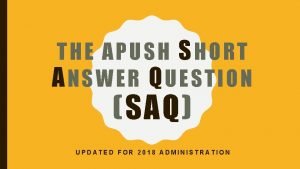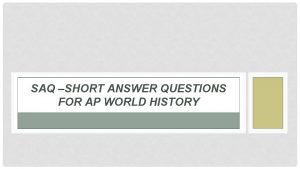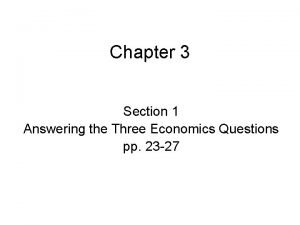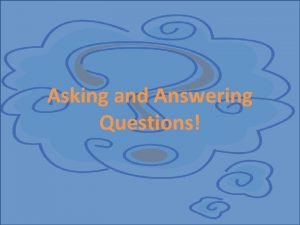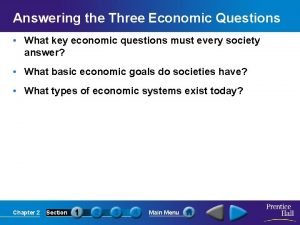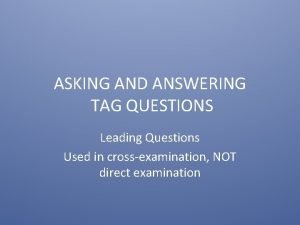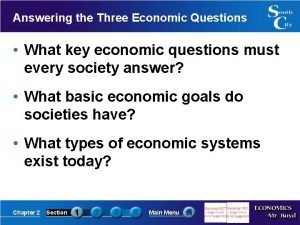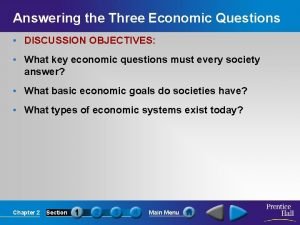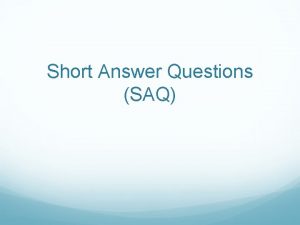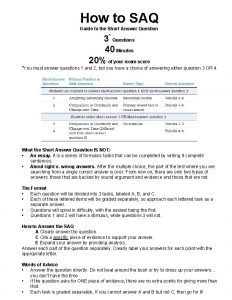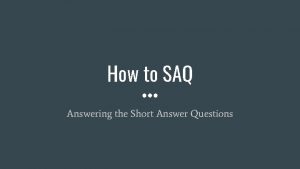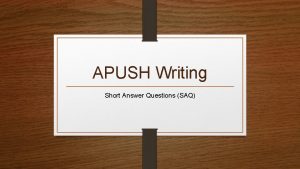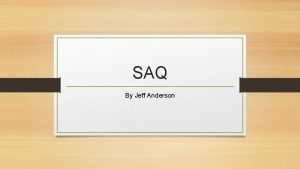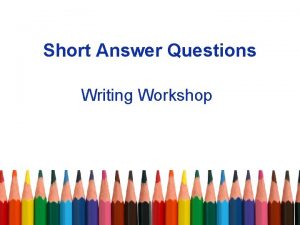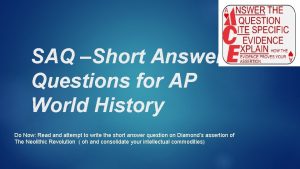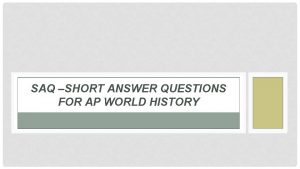How to SAQ Answering the Short Answer Questions













- Slides: 13

How to SAQ Answering the Short Answer Questions

On the Exam ● 3 Questions, 20% of Exam, 40 minutes (13 minutes each) ● Question 1: Required, Secondary Source Stimulus, 1200 -2001 ● Question 2: Required, Primary Source Stimulus, 1200 -2001 ● Question 3 or 4: Pick ONE, no stimulus, #3 from 1200 -1750, #4 from 1750 -2001

SECONDARY SOURCE EXAMPLE

PRIMARY SOURCE EXAMPLE

NO STIMULUS EXAMPLE

Strategies for Answering the SAQ There are many ways to approach the SAQ. However, a solid response to an SAQ will do three things : 1) directly answer the prompt 2) use specific facts and content-specific vocabulary 3) explain your reasoning thoroughly.

Some tips for students: ● Reword the promptin the answer to be clear what you are answering and to stay on topic ● Be sure to address the HTS(historical thinking skill) used--employ CCOT and comparison language ● If there is a stimulus, you MUST refer to the stimulusin your answer ● Must include specific historical evidence (SHE), vague references or generalities are not enough (use facts like specific relevant names and dates) ● Assume the reader has no background and make sure all your ideas are stated clearly ● Use complete sentences(no bullet points or outlines)

Best Strategy…. . . A. C. E. the Question! Answer the question Cite an example Explain your reasoning

Answer the question, Cite an example, Explain Example: A. Identify and explain ONE way in which industrialization in the period circa 1750– 1900 can be considered an economic turning point in global history. A. One way in which industrialization can be considered an economic turning point is that mechanized production replaced traditional ways of creating consumer products. For example, the mechanization of textiles replaced the traditional, hand-woven textile industry in India. Machinedriven production was cheaper and faster, which made products more accessible to people.

“The more power a government has, the more it can act arbitrarily according to the whims and desires of the elite, and the more it will make war on others and murder its foreign and domestic subjects. The more constrained the power of governments, the more power is diffused, checked, and balanced, the less it will aggress on others and commit mass violence. At the extremes of power, totalitarian governments slaughter their people by the tens of millions. In contrast, many democracies can barely bring themselves to execute even serial murderers. ” Rudolph Rummel, United States political scientist, Death by

A. Identify ONE historical example of mass violence that was committed by a totalitarian state in the twentieth century that would support Rummel’s argument in the passage. One example of mass murder committed by a totalitarian state in the 20 th century was the Holocaust. Nazi Germany was an authoritarian, fascist regime that carried out the deaths of over 11 million targeted people. The totalitarian dictatorship under Adolf Hitler allowed them to carry out genocide through laws, deportations, and mass extermination camps.

B. Explain ONE historical example of a democratic state committing mass violence that would challenge Rummel’s argument regarding democracies and mass violence. One example of mass murder committed by a democratic state would be the use of atomic weapons by the United States during World War II. In 1945, under President Truman, the US decided to strategically drop two atomic weapons in Japan, killing hundreds of thousands of civilians in minutes. This decision was checked through the US Constitution, but was still carried out in order to end the war and prevent further death.

C. Explain ONE development in the late twentieth century that likely shaped Rummel’s view of the relationship between democracy and mass violence Rummel was likely influenced by the Cold War, which had ended with the crumbling of the Soviet Union just a few years before this was written. During the Cold War, the battle between capitalist, democratic societies and communist, totalitarian states would have influenced Rummel to consider mass murder as a defining difference between the two types of regimes.
 Tall + short h
Tall + short h Saq meaning apush
Saq meaning apush Ace in apush
Ace in apush How to write an saq ap world
How to write an saq ap world Present continous exercises
Present continous exercises Answering the three economic questions
Answering the three economic questions Asking questions in spanish
Asking questions in spanish Chapter 2 section 1 answering the three economic questions
Chapter 2 section 1 answering the three economic questions Answering tag questions
Answering tag questions Chapter 2 section 1 answering the three economic questions
Chapter 2 section 1 answering the three economic questions Answering the three economic questions section 1 quiz
Answering the three economic questions section 1 quiz Saq answer sheet
Saq answer sheet Saq guide
Saq guide Saq answer example
Saq answer example

